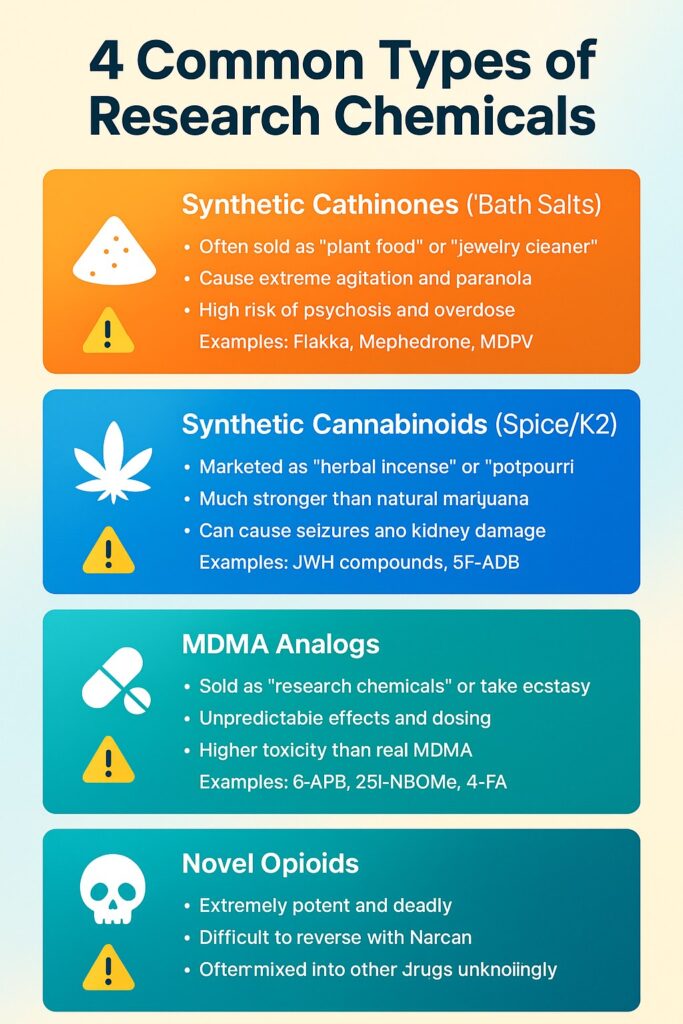The landscape of substance abuse has evolved dramatically in recent years with the emergence of research chemicals, also known as designer drugs, novel psychoactive substances (NPS), or synthetic drugs. These laboratory-created compounds pose significant dangers to users and present unique challenges for addiction treatment professionals. At Healthy Life Recovery, we’ve seen firsthand how these substances can devastate lives and complicate the recovery process.
What Are Research Chemicals?
Research chemicals are synthetic substances designed to mimic the effects of illegal drugs while technically remaining legal through slight molecular modifications. Originally developed for legitimate scientific research, these compounds have been diverted to recreational use, creating a dangerous and largely unregulated market of experimental drugs.
According to the United Nations Office on Drugs and Crime (UNODC), novel psychoactive substances are defined as substances that “are not controlled by the 1961 Single Convention on Narcotic Drugs or the 1971 Convention on Psychotropic Substances, but which may pose a public health threat.” The UNODC reports that 151 countries and territories worldwide have reported novel psychoactive substances, highlighting the global scope of this issue.
The term “research chemical” is somewhat misleading—while these substances may have been created in research settings, the versions sold on the street or online have rarely undergone proper safety testing or quality control. Users essentially become unwitting test subjects for untested chemical compounds.
Why Research Chemicals Exist
The primary reason research chemicals proliferate is to circumvent drug laws. When a specific substance is banned, chemists create slightly modified versions that aren’t technically covered by existing legislation. This creates a constant game of “chemical whack-a-mole” between lawmakers and manufacturers.
The U.S. Drug Enforcement Administration’s Controlled Substances Act provides the legal framework for controlling substances, but it typically regulates individual compounds rather than entire classes, allowing manufacturers to create new variants as soon as specific substances are banned.
Profit Motivation
These substances can be manufactured cheaply in unregulated laboratories and sold at high markups. The profit margins are substantial, incentivizing continued production despite the risks.
Accessibility
Research chemicals are often sold online under the guise of “research purposes only” or “not for human consumption,” making them easily accessible to people who might not otherwise have access to traditional illegal drugs.
Curiosity and Novelty-Seeking
Some users are attracted to the novelty of trying “new” substances or believe they’re safer because they’re “legal” or “natural”—dangerous misconceptions that can have deadly consequences. This novelty-seeking behavior is one of the traits of an addictive personality that makes individuals particularly vulnerable to experimental substances.
Major Categories of Research Chemicals
Research chemicals span numerous drug classes, each designed to mimic different types of controlled substances while exploiting legal loopholes. Understanding these categories is crucial for recognizing their effects and dangers. The following sections outline the most commonly encountered types of research chemicals, their street names, and their specific risks.
MDMA Analogs and Substituted Phenethylamines
Common Examples: 6-APB, 5-MAPB, 4-FA, 2C-B, 25I-NBOMe
These substances attempt to replicate the empathogenic and stimulant effects of MDMA (ecstasy). However, their effects can be unpredictable and potentially more dangerous than MDMA itself.
Dangers:
- Unpredictable dosing and potency
- Increased risk of hyperthermia and dehydration
- Cardiovascular complications
- Severe psychological effects including psychosis
- Higher addiction potential than MDMA
Synthetic Cathinones ("Bath Salts")
Common Examples: Mephedrone, MDPV, α-PVP (Flakka), 4-MMC
Synthetic cathinones are stimulants chemically related to the naturally occurring compound found in the khat plant. Despite being sold as “bath salts” or “plant food,” these substances are designed for human consumption. According to research published in the National Center for Biotechnology Information, these substances are often mislabeled to evade legal restrictions.
Effects and Dangers:
- Intense stimulation and euphoria
- Extreme agitation and paranoia
- Hyperthermia and cardiovascular stress
- Compulsive redosing behavior
- "Excited delirium" syndrome
- High potential for addiction and psychosis
Synthetic Cannabinoids ("Spice," "K2")
Common Examples: JWH compounds, AM-2201, 5F-ADB, MDMB-CHMICA
These substances are designed to activate the same brain receptors as THC but often produce dramatically different and more dangerous effects. The National Institute on Drug Abuse (NIDA) reports that synthetic cannabinoids are part of a group called new psychoactive substances (NPS) that are unregulated and intended to produce effects similar to illegal drugs.
Unique Dangers:
- Unpredictable and severe psychological effects
- Seizures and kidney damage
- Extreme anxiety and psychosis
- No quality control in manufacturing
- Constantly changing chemical formulations
Dissociative Research Chemicals
Common Examples: MXE (Methoxetamine), 3-MeO-PCP, DCK (Deschloroketamine)
While ketamine has legitimate medical uses and is being studied for treating depression, its research chemical analogs lack proper testing and medical oversight.
Risks Include:
- Dissociation from reality
- Memory problems and cognitive impairment
- Bladder and urological damage
- Increased accident risk due to impaired coordination
- Potential for psychological dependence
Novel Opioids
Common Examples: U-47700, AH-7921, MT-45
Perhaps the most dangerous category, synthetic opioids can be hundreds of times more potent than traditional opioids like heroin. The National Institute on Drug Abuse’s Designer Drug Research Unit specifically studies these substances, which are engineered to circumvent drug control laws and often misused to avoid detection.
Extreme Dangers:
- Extremely high overdose risk
- Rapid development of tolerance and dependence
- Difficult to reverse overdoses with naloxone (Narcan)
- Often mixed with other drugs unknowingly
- High fatality rates
Understanding signs of a fentanyl overdose can be life-saving, as many novel opioids produce similar symptoms.
Psychedelic Research Chemicals
Common Examples: 25I-NBOMe, DOB, 2C-E, 4-AcO-DMT
These substances attempt to replicate the effects of classic psychedelics like LSD or psilocybin but often with increased risks and unpredictable effects.
Specific Risks:
- Severe psychological distress and panic
- Dangerous behavior during intoxication
- Flashbacks and persistent psychosis
- Physical symptoms including seizures
- Often sold as other substances (like LSD)
The unpredictable nature of these substances can lead to marijuana psychosis when synthetic cannabinoids are involved, or other forms of drug-induced psychosis.
The Unique Dangers of Research Chemicals
One of the most significant dangers of research chemicals is that users never know exactly what they’re taking. A comprehensive study published in PubMed found that these substances are commonly mislabeled as “not for human consumption” and sold online, with street samples often containing:
- Multiple active compounds
- Impurities from poor manufacturing
- Completely different substances than advertised
- Varying concentrations with no quality control
Lack of Safety Data
Unlike approved medications or even well-studied illegal drugs, research chemicals have little to no safety data. The National Institute on Drug Abuse emphasizes that because drug markets change quickly, these emerging drugs have unpredictable health effects and may be as powerful or more powerful than existing drugs. Users don’t know:
- Safe dosing ranges
- Potential interactions with other substances
- Long-term health effects
- How to recognize or treat overdoses
Unpredictable Effects
Because these substances are designed to circumvent drug laws rather than optimize safety or effectiveness, their effects can be:
- Much stronger or weaker than expected
- Completely different from intended drugs they're meant to mimic
- Highly variable between batches
- Subject to dangerous interactions
Detection Challenges
Many research chemicals don’t show up on standard drug tests, creating several problems. Research published in the National Center for Biotechnology Information notes that substances in these classes often escape detection in screening tests, creating challenges for:
- Medical professionals may not identify the cause of symptoms
- Users may falsely believe they're undetectable
- Emergency treatment becomes more difficult
- Legal and employment consequences may be delayed but severe
Evolving Formulations
As specific compounds become illegal, manufacturers constantly modify formulations, meaning:
- Previous experience provides no safety guidance
- Each new variant is essentially a new experiment
- Users can't develop tolerance patterns
- Treatment protocols are constantly outdated
Health Consequences and Addiction Potential
The health impacts of research chemicals can be both immediate and long-lasting, often exceeding the dangers associated with traditional drugs of abuse. Because these substances lack proper testing and quality control, users face unpredictable health consequences that can affect multiple organ systems and lead to rapid addiction development.
Acute Health Risks
Research chemicals can cause immediate and severe health problems:
- Cardiovascular events: Heart attacks, strokes, dangerous blood pressure changes
- Neurological effects: Seizures, brain damage, persistent psychosis
- Respiratory depression: Particularly with synthetic opioids
- Hyperthermia: Dangerous overheating that can be fatal
- Kidney and liver damage: From toxic compounds and adulterants
Long-Term Health Effects
While long-term studies are lacking, concerning patterns are emerging:
- Persistent cognitive impairment
- Chronic mental health problems
- Organ damage, particularly to kidneys and liver
- Increased risk of infectious diseases
- Accelerated aging and physical deterioration
Addiction and Dependence
Many research chemicals have high addiction potential, often exceeding that of traditional drugs:
- Rapid tolerance development: Requiring increasingly dangerous doses
- Severe withdrawal symptoms: Often without established treatment protocols
- Compulsive use patterns: Particularly with synthetic cathinones
- Cross-addiction risks: Potentially increasing vulnerability to other substances
- Kidney and liver damage: From toxic compounds and adulterants
Treatment Challenges
Treating research chemical addiction requires specialized approaches that differ significantly from standard addiction treatment protocols. The experimental nature of these substances, combined with their unpredictable effects and unknown compositions, creates unique challenges for healthcare providers and complicates the recovery process.
Diagnostic Difficulties
Treating research chemical addiction presents unique challenges:
- Unknown substances: Medical teams can't identify what the person has used
- No established protocols: Treatment approaches must be developed case-by-case
- Unpredictable withdrawal: Symptoms may not follow typical patterns
- Poly-substance complications: Research chemicals are often used with other drugs
Specialized Care Requirements
Effective treatment of research chemical addiction often requires:
- Extended detoxification periods: Due to unknown half-lives and effects
- Comprehensive medical monitoring: For unpredictable health complications
- Psychiatric support: Due to high rates of co-occurring mental health issues
- Individualized treatment plans: Standard protocols may not apply
Prevention and Education
Preventing research chemical abuse requires comprehensive education and awareness efforts targeting both potential users and their families. Early recognition of warning signs and understanding of harm reduction principles can be life-saving, while education helps dispel dangerous misconceptions about these substances.
Recognizing the Warning Signs
Family members and friends should watch for:
- Packages arriving with vague or scientific-sounding names
- Purchasing from overseas or online chemical suppliers
- Possession of substances in unmarked containers
- Dramatic behavioral changes or health problems
- Use of terms like "research chemicals," "plant food," or "bath salts"
For additional guidance, review our comprehensive guide on signs of teen drug abuse and how to help an addict or alcoholic who doesn’t want help.
Harm Reduction Information
While abstinence is the safest approach, harm reduction strategies include:
- Never use alone: Have someone present who can call for help
- Start with tiny amounts: Unknown potency makes overdose likely
- Avoid mixing substances: Interactions are completely unpredictable
- Keep emergency contacts available: Including poison control and emergency services
- Consider drug checking services: Where available and appropriate
Understanding atypical presentations of overdose is crucial since research chemicals may not produce recognizable overdose symptoms.
Treatment at Healthy Life Recovery
At Healthy Life Recovery, we understand the unique challenges posed by research chemical addiction and provide specialized care tailored to these complex substances. Our medically supervised detox program offers 24/7 medical monitoring for unpredictable withdrawal symptoms, individualized medication management, and psychiatric support for drug-induced mental health issues. We incorporate evidence-based therapies including Cognitive Behavioral Therapy (CBT), Dialectical Behavior Therapy (DBT), EMDR therapy, and Brainspotting therapy to address the complex psychological aspects of research chemical addiction.
For particularly challenging cases, we offer advanced treatment modalities including qEEG Brain Mapping to assess neurological damage, TMS Therapy for treatment-resistant depression, GeneSight Testing to optimize medication selection, and Ketamine Therapy for severe depression under medical supervision. Our holistic treatment approach addresses physical healing through nutrition and exercise, mental health through therapy and medication management, and spiritual growth through mindfulness and community connection. Many individuals using research chemicals have co-occurring mental health conditions, so our dual diagnosis program simultaneously addresses substance use disorders alongside depression and anxiety, PTSD and trauma-related disorders, and bipolar disorder.
Recovery and Long-Term Support
Following initial stabilization, our comprehensive recovery support continues through multiple levels of care. Our outpatient programs provide continued therapy and support, medication management, relapse prevention education, and family involvement, with our evening outpatient program (IOP) being particularly beneficial for those transitioning back to work or school while maintaining intensive treatment support. Our sober living partnerships offer structured, substance-free environments with peer support from others in recovery, gradual reintegration into independent living, and continued access to treatment services.
Our unique Active Recovery Tracks help rebuild healthy lifestyles through physical activities like surfing, yoga, and martial arts, creative outlets including music production, outdoor activities like motocross and golf that promote natural endorphin release, and social connections built around healthy activities.

Medically Reviewed By:
Dr. Sanjai Thankachen
Dr. Sanjai Thankachen graduated from Adichunchanagiri Institute of Medicine in 2000. He completed his residency in psychiatry in 2008 at Creedmoor Psychiatric Center in New York. Dr. Thankachen is currently working with Pacific Neuropsychiatric Specialists in an outpatient practice, as well as working at multiple in-patient psychiatric and medical units bringing his patients the most advanced healthcare treatment in psychiatry. Dr. Thankachen sees patients with an array of disorders, including depression, bipolar illness, schizophrenia, anxiety, and dementia-related problems.

Edited for Clinical Accuracy By:
Sean Leonard, Psychiatric Nurse Practitioner
Sean Leonard is a board-certified psychiatric nurse practitioner. He received his master’s degree in adult geriatric primary care nurse practitioner from Walden University and a second postmaster specialty in psychiatry mental health nurse practitioner from Rocky Mountain University. Sean has experience working in various diverse settings, including an outpatient clinic, inpatient detox and rehab, psychiatric emergency, and dual diagnosis programs. His specialty areas include substance abuse, depression, anxiety, mood disorders, PTSD, ADHD, and OCD.

